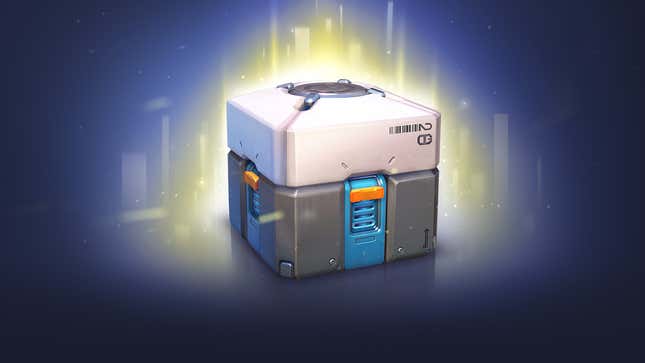
Today the Entertainment Software Rating Board (ESRB) announced a new ratings description specifically for games with loot boxes.
Currently, games that have microtransactions in them come with an ESRB description that states “In-Game Purchases.” The ESRB is now going to add the follow-up description “Includes Random Items” if there are items players can buy in a game that have a randomly generated element. For the most part this means loot boxes, but the description would also apply to any other microtransaction in which luck is involved.
“In-Game Purchases (Includes Random Items) will be assigned to all games that include purchases with any randomized elements, including loot boxes, gacha games, item or card packs, prize wheels, treasure chests, and more,” the ratings agency wrote in its announcement. “Games that have the In-Game Purchases (Includes Random Items) notice may also include other non-randomized paid elements.”
The “In-Game Purchases” description is itself a fairly recent development. It was originally added in early 2018, but only after mounting pressure from politicians and the public following the controversy around Star Wars: Battlefront II’s loot boxes. At the same time the description was so broad it didn’t distinguish between regular microtransactions and those predicated on chance.
“I’m sure you’re all asking why aren’t we doing something more specific to loot boxes,” ESRB president Patricia Vance said in a press release at the time. “We’ve done a lot of research over the past several weeks and months, particularly among parents. What we’ve learned is that a large majority of parents don’t know what a loot box is. Even those who claim they do, don’t really understand what a loot box is. So it’s very important for us to not harp on loot boxes per se, to make sure that we’re capturing loot boxes, but also other in-game transactions.”
The ESRB now says it will do just that. “Since adding the In-Game Purchases notice to ratings assigned to physical games many game consumers and enthusiasts (not necessarily parents) have reached out to us asking the ESRB to include additional information to identify games that include randomized purchases,” the agency wrote. The descriptions still won’t be using the phrase “loot box,” though, because in the ESRB’s words, “most people less familiar with games do not understand it.”
In the past the ESRB had been resistant to calling out loot boxes in games, telling Kotaku back in 2017 that it didn’t consider them to be gambling. By now many games have already replaced their loot boxes with battle passes and other forms of in-game microtransactions. Better late than never, I guess.